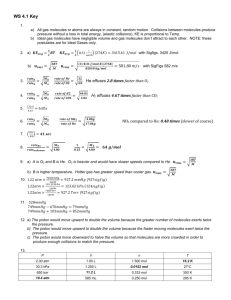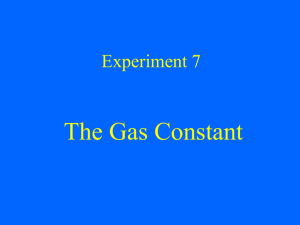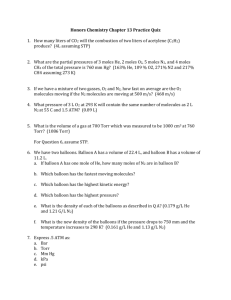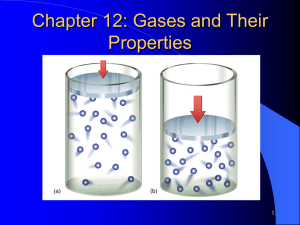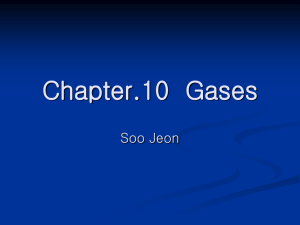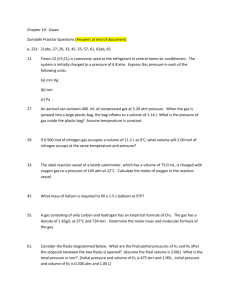AP Chemistry WS 4.1 Key All gas molecules or atoms are always in
advertisement
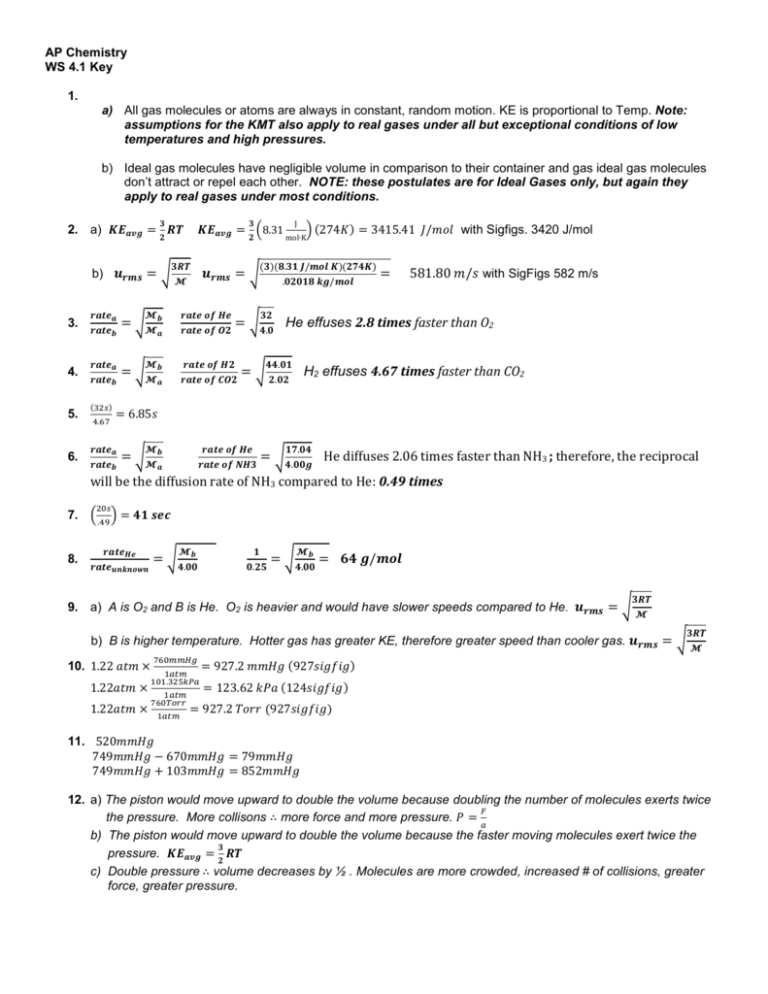
AP Chemistry WS 4.1 Key 1. a) All gas molecules or atoms are always in constant, random motion. KE is proportional to Temp. Note: assumptions for the KMT also apply to real gases under all but exceptional conditions of low temperatures and high pressures. b) Ideal gas molecules have negligible volume in comparison to their container and gas ideal gas molecules don’t attract or repel each other. NOTE: these postulates are for Ideal Gases only, but again they apply to real gases under most conditions. 𝟑 2. a) 𝑲𝑬𝒂𝒗𝒈 = 𝑹𝑻 𝟑𝑹𝑻 𝓜 b) 𝒖𝒓𝒎𝒔 = √ 3. 4. 5. 6. 𝒓𝒂𝒕𝒆𝒂 𝒓𝒂𝒕𝒆𝒃 = √𝓜𝒃 𝒓𝒂𝒕𝒆𝒂 𝒓𝒂𝒕𝒆𝒃 = √𝓜𝒃 (32𝑠) 4.67 𝓜 𝓜 mol∙K ) (274𝐾) = 3415.41 𝐽/𝑚𝑜𝑙 with Sigfigs. 3420 J/mol (𝟑)(𝟖.𝟑𝟏 𝑱/𝒎𝒐𝒍 𝑲)(𝟐𝟕𝟒𝑲) .𝟎𝟐𝟎𝟏𝟖 𝒌𝒈/𝒎𝒐𝒍 = 581.80 𝑚/𝑠 with SigFigs 582 m/s 𝟑𝟐 = √𝟒.𝟎 He effuses 2.8 times faster than O2 𝒓𝒂𝒕𝒆 𝒐𝒇 𝑯𝟐 𝒓𝒂𝒕𝒆 𝒐𝒇 𝑪𝑶𝟐 𝒂 J 𝟐 𝒖𝒓𝒎𝒔 = √ 𝒓𝒂𝒕𝒆 𝒐𝒇 𝑯𝒆 𝒓𝒂𝒕𝒆 𝒐𝒇 𝑶𝟐 𝒂 𝟑 𝑲𝑬𝒂𝒗𝒈 = (8.31 𝟐 𝟒𝟒.𝟎𝟏 H2 effuses 4.67 times faster than CO2 = √ 𝟐.𝟎𝟐 = 6.85𝑠 𝒓𝒂𝒕𝒆𝒂 𝒓𝒂𝒕𝒆𝒃 𝓜 𝒓𝒂𝒕𝒆 𝒐𝒇 𝑯𝒆 𝒓𝒂𝒕𝒆 𝒐𝒇 𝑵𝑯𝟑 = √𝓜𝒃 𝒂 𝟏𝟕.𝟎𝟒 = √𝟒.𝟎𝟎𝒈 He diffuses 2.06 times faster than NH3 ; therefore, the reciprocal will be the diffusion rate of NH3 compared to He: 0.49 times 7. ( 8. 20𝑠 .49 ) = 𝟒𝟏 𝒔𝒆𝒄 𝒓𝒂𝒕𝒆𝑯𝒆 𝒓𝒂𝒕𝒆𝒖𝒏𝒌𝒏𝒐𝒘𝒏 𝓜 = √𝟒.𝟎𝟎𝒃 𝟏 𝟎.𝟐𝟓 𝓜 = √𝟒.𝟎𝟎𝒃 = 𝟔𝟒 𝒈/𝒎𝒐𝒍 𝟑𝑹𝑻 𝓜 9. a) A is O2 and B is He. O2 is heavier and would have slower speeds compared to He. 𝒖𝒓𝒎𝒔 = √ 𝟑𝑹𝑻 𝓜 b) B is higher temperature. Hotter gas has greater KE, therefore greater speed than cooler gas. 𝒖𝒓𝒎𝒔 = √ 10. 1.22 𝑎𝑡𝑚 × 1.22𝑎𝑡𝑚 × 1.22𝑎𝑡𝑚 × 760𝑚𝑚𝐻𝑔 1𝑎𝑡𝑚 101.325𝑘𝑃𝑎 1𝑎𝑡𝑚 760𝑇𝑜𝑟𝑟 1𝑎𝑡𝑚 = 927.2 𝑚𝑚𝐻𝑔 (927𝑠𝑖𝑔𝑓𝑖𝑔) = 123.62 𝑘𝑃𝑎 (124𝑠𝑖𝑔𝑓𝑖𝑔) = 927.2 𝑇𝑜𝑟𝑟 (927𝑠𝑖𝑔𝑓𝑖𝑔) 11. 520𝑚𝑚𝐻𝑔 749𝑚𝑚𝐻𝑔 − 670𝑚𝑚𝐻𝑔 = 79𝑚𝑚𝐻𝑔 749𝑚𝑚𝐻𝑔 + 103𝑚𝑚𝐻𝑔 = 852𝑚𝑚𝐻𝑔 12. a) The piston would move upward to double the volume because doubling the number of molecules exerts twice 𝐹 the pressure. More collisons ∴ more force and more pressure. 𝑃 = 𝑎 b) The piston would move upward to double the volume because the faster moving molecules exert twice the 𝟑 pressure. 𝑲𝑬𝒂𝒗𝒈 = 𝑹𝑻 𝟐 c) Double pressure ∴ volume decreases by ½ . Molecules are more crowded, increased # of collisions, greater force, greater pressure. 13. P V n T 2.00 atm 1.00 L 1.500 mol 16.2 K 30.3 kPa 1.250 L 0.0152 mol 27oC 650 torr 11.2 L 0.333 mol 350 K 585 mL 0.250 mol 295 K 10.4 atm 14. a) 𝑃𝑉 = 𝑛𝑅𝑇 𝑛= b) 0.382𝑚𝑜𝑙𝑂2 × 15. 𝑷𝟏 𝑽𝟏 = 𝒏𝟏 𝑻𝟏 𝑇2 = 16. 𝑚 𝑉 = 32.0 𝑔 𝑂2 1 𝑚𝑜𝑙 (94.6𝑘𝑃𝑎)(10.0𝐿) (8.31)(298𝐾) (𝟕𝟓𝟎𝒕𝒐𝒓𝒓)(𝟑𝟓𝟎𝒎𝑳) 𝒏𝟐 𝑻𝟐 𝒏𝟏 (𝟐𝟖𝟖𝑲) (750𝑡𝑜𝑟𝑟)(450𝑚𝐿)(288𝐾)(𝑛1 ) (750𝑡𝑜𝑟𝑟)(350𝑚𝐿)(𝑛2 ) 𝑃∙ℳ given 𝑅∙𝑇 𝑚 𝑃∙ℳ = 𝑅∙𝑇 𝑉 𝑃∙ℳ 𝑅∙𝑇 18. = = 𝟎. 𝟑𝟖𝟐 𝒎𝒐𝒍 = 𝟏𝟐. 𝟐 𝒈 𝑶𝟐 𝑷𝟐 𝑽𝟐 =𝑑= 17. 𝑑 = 𝑃𝑉 𝑅𝑇 = (𝟕𝟓𝟎𝒕𝒐𝒓𝒓)(𝟒𝟓𝟎𝒎𝑳) 𝒏𝟐 𝑻𝟐 rearrange and solve for T2 = 𝟑𝟕𝟎. 𝟑 𝑲 This is really just Charles Law the information, rearrange solving for molar mass(M) 𝑚𝑅𝑇 𝑃 =ℳ (1𝑎𝑡𝑚)(17.04𝑔/𝑚𝑜𝑙) (.0821)(273) = (4.93𝑔)(.0821)(400𝐾) 1.05𝑎𝑡𝑚 = 𝟏𝟓𝟒. 𝟐𝒈/𝒎𝒐𝒍 = .76 𝑔/𝐿 Total Pressure Partial Pressure of He Density Average Kinetic energy per molecule 1 1 2 1 19. a. the number of moles of each gas. n = PV/RT = (265/760)(1.0)/(0.0821)(298) n = 0.014 mol n = PV/RT = (800/760)(1.0)/(0.0821)(298) n = 0.043 mol n = PV/RT = (532/760)(0.5)/(0.0821)(298) n = 0.014 mol N2 Ne H2 b. the total pressure after all valves are opened. P = nRT/V = (0.071)(0.0821)(298)/(2.5) P = 0.695 atm (528 torr) c. the partial pressure of each gas. PN2 = XN2Ptot = (0.014/0.071)(528 torr) N2 PN2 = 104 torr PNe = XNePtot = (0.043/0.071)(528 torr) Ne PNe = 320 torr PH2 = XH2Ptot = (0.014/0.071)(528 torr) H2 PH2 = 104 torr 740 = PH2 + 32torr PH2 = 708 torr 20. a) Ptot = PH2 + PH2O b) 𝑃𝑉 = 𝑛𝑅𝑇 𝑛 = 𝑃𝑉 𝑅𝑇 = (0.932𝑎𝑡𝑚)(2.0𝐿) (.0821)(303𝐾) = 𝟕. 𝟓 × 𝟏𝟎−𝟐 𝒎𝒐𝒍 21. a) 𝑃𝐻2 = 745 𝑚𝑚𝐻𝑔 − 23.8𝑚𝑚𝐻𝑔 = 𝟕𝟐𝟏. 𝟐 𝒎𝒎 𝑯𝒈 𝑛= 𝑃𝑉 𝑅𝑇 = (.949𝑎𝑡𝑚)(.090 𝐿) 𝑅(298𝐾) = 𝟑. 𝟒𝟗 × 𝟏𝟎−𝟑 𝒎𝒐𝒍𝒆𝒔 𝑯𝟐 3 2 3 1 1 3 1 1 Both I and III have the same # of molecules, therefore same pressure b) First convert 23.8 mm Hg to atm 𝑃𝑉 (0.0313𝑎𝑡𝑚)(.090 𝐿) 6.02 × 1023 𝑛= = = 𝟏. 𝟏𝟓 × 𝟏𝟎−𝟒 𝒎𝒐𝒍𝒆𝒔 𝑯𝟐 𝑶 × = 𝟔. 𝟗𝟑 × 𝟏𝟎𝟏𝟗 𝒎𝒐𝒍𝒆𝒄𝒖𝒍𝒆𝒔 𝑯𝟐 𝑶 1 𝑚𝑜𝑙𝑒 𝑅𝑇 𝑅(298𝐾) c) 𝑟𝑎𝑡𝑒 𝑜𝑓 𝐻2 𝑟𝑎𝑡𝑒 𝑜𝑓 𝐻2𝑂 = √18.02 √2.02 = 𝟐. 𝟗𝟖 𝒕𝒊𝒎𝒆𝒔 d) H2O because it is a polar molecule and in fact attracts to other water molecules due to hydrogen IMF bonding. The stronger the IMF, the more the molecule or atom will deviate from ideal gas behavior. At low T and high P conditions molecules with stronger IMF will attract more to each other and collide less often with the container walls. a) 𝑷𝑻 = 22. b) 𝑛𝑅𝑇 𝑉 = (0.60𝑚𝑜𝑙)𝑅(300𝐾) 20.0 𝐿 𝑷𝑶𝟐 = 𝝌𝑶𝟐 ∙ 𝑷𝑻 = ( 𝟎.𝟔𝒎𝒐𝒍 1𝑚𝑜𝑙 23. 24.2 g He × 4.00𝑔 = 6.05 𝑚𝑜𝑙 𝐻𝑒 𝑃𝑇 = (6.185𝑚𝑜𝑙)𝑅(298𝐾) 1.5 𝐿 = 𝟎. 𝟕𝟑𝟗𝒂𝒕𝒎 𝒐𝒓 𝟕𝟒. 𝟖𝟓 𝒌𝑷𝒂 𝟎.𝟐𝒎𝒐𝒍 = 12.1𝑎𝑡𝑚 ) ∙ 𝟕𝟒. 𝟖𝟓𝒌𝑷𝒂 = 𝟐𝟒. 𝟗𝟓𝒌𝑷𝒂 4.32 g 𝑂2 × 𝑃𝐻𝑒 = ( 1𝑚𝑜𝑙 32.00𝑔 = 0.135 𝑚𝑜𝑙 𝑂2 6.05 𝑚𝑜𝑙 6.185 𝑚𝑜𝑙 ) ∙ 12.1𝑎𝑡𝑚 = 𝟏𝟏. 𝟖𝒂𝒕𝒎 𝑃𝑂2 = ( 0.135 𝑚𝑜𝑙 6.185 𝑚𝑜𝑙 ) ∙ 12.1𝑎𝑡𝑚 = 𝟎. 𝟐𝟔 𝒂𝒕𝒎 24. a) b) All gases have the same KE avg. because temperature is the same and temperature is a measure of KE. He because it has the lowest MM. At the same temperature, the square of the velocity of any gas varies inversely with its molar 𝟑𝑹𝑻 mass. 𝒖𝒓𝒎𝒔 = √ c) d) e) f) 𝓜 He because partial pressure is proportional to the number of moles of gas present and the # of moles increases with decreasing molar mass. 3.00 g of each gas, so if you convert to moles of each, you will see that the lower MM will have the most moles. SO2 is the largest, most complex and they are the most polar. SO2 uses dipole-dipole bonding which is the strongest of the IMF’s, the other gases only use LDF. SO2 because again it uses dipole-dipole intermolecular bonding which is stronger than the LDF, therefore higher BP. decreasing T and increasing P.

